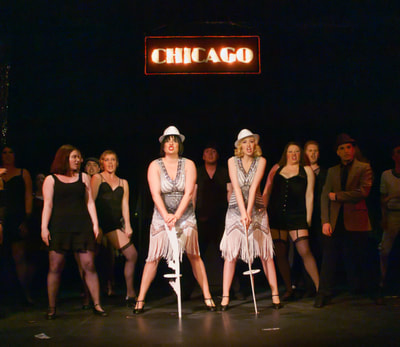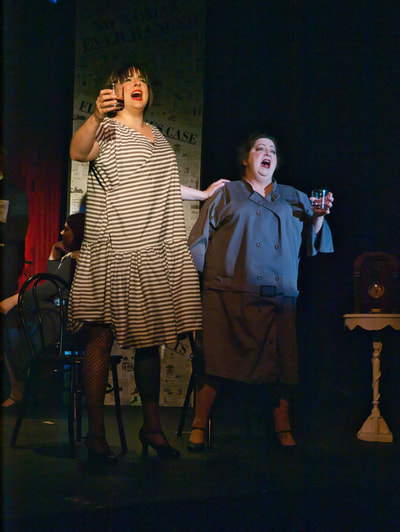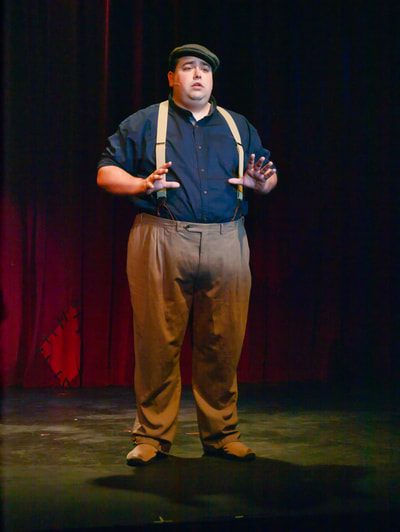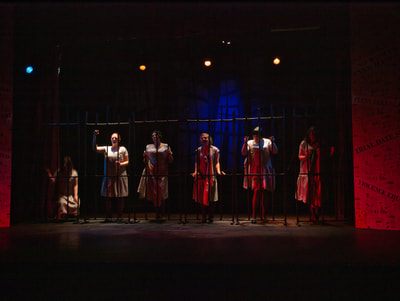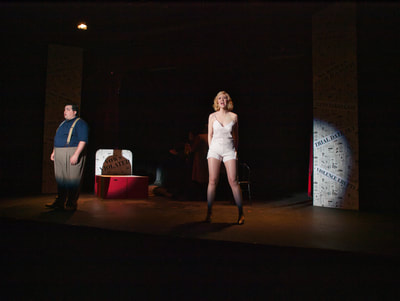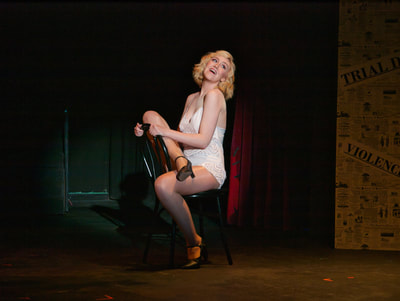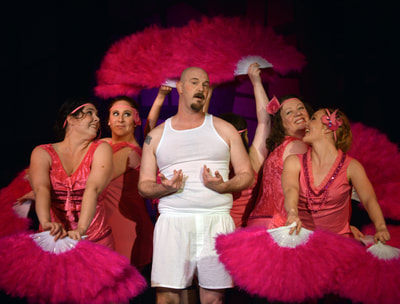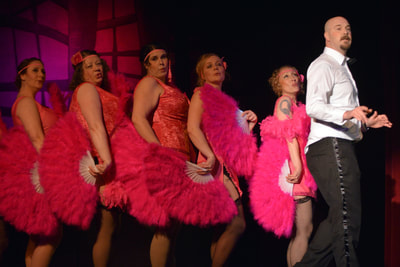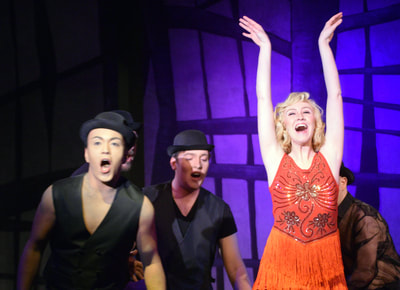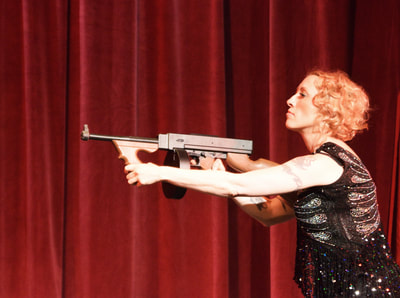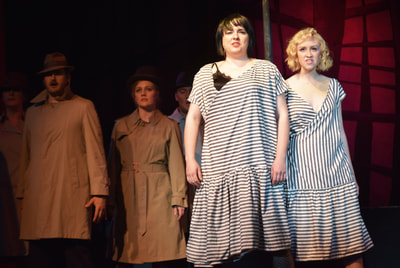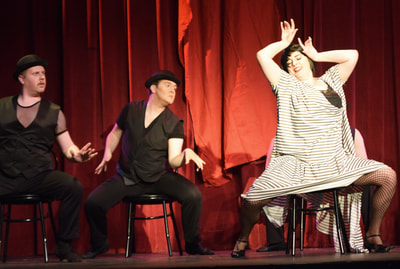Chicago(In performance)
May 4 - June 3, 2018 Ferndale Repertory Theatre, Ferndale CA Patrick Spike - Director & Co-Choreographer Alexandra Blouin - Co-Choreographer Molly Severdia - Music Director Elaine Althouse & Nan Voss - Vocal Directors Cecilia Beaton - Scenic Designer Cindy Shepherd - Costume Designer Dillon Savage - Sound Designer Emilia Bjork - Properties Designer/ Artist-Administrator in Residence JuanCarlos Contreras - Production Stage Manager Jeff Cooper - Stage Manager Grady Moore - Assistant Stage Manager Carl McGahan - Technical Director/ Master Carpenter Liz Uhazy - Lighting Designer Leira Satlof - Artistic Producing Director |
Reviews
"Every song and it clever staging gives the talented FRT performers chances to shine..." "So, bravos go to the behind-the-scenes people who got them there: inventive director/choreographer Patrick Spike..." "... don't miss out on seeing one of the most exciting and entertaining musicals of this, or any other, year in Humboldt County theater!" - Betti Trauth, Times-Standard / Urge [FULL REVIEW HERE]
Production Photos - Dan Tubbs
All rights reserved. Please contact me for permission to download or share.
Production Photos - Kristi Patterson
Director's notes for production
Chicago
Patrick Spike – Director
Source material / History:
The musical Chicago is based on a play of the same name by reporter and playwright Maurine Dallas Watkins, who was assigned to cover the 1924 trials of accused murderers Beulah Annan and Belva Gaertner for the Chicago Tribune.
In the early 1920s, Chicago's press and public became riveted by the subject of homicides committed by women. Several high-profile cases arose, which generally involved women killing their lovers or husbands. These cases were tried against a backdrop of changing views of women in the Jazz age, and a long string of acquittals by Cook County juries of women murderesses (jurors at the time were all men, and convicted murderers generally faced death by hanging). A lore arose that, in Chicago, feminine or attractive women could not be convicted. The Chicago Tribune generally took a pro-prosecution "hang-them-high" stance, while still presenting the details of these women's lives. Its rivals at the Hearst papers were more pro-defendant, and employed what were derisively called "sob-sisters" – women reporters who focused on the plight, attractiveness, redemption, or grace of the women defendants. Regardless of stance, the press covered several of these women as celebrities.
Annan, the model for the character of Roxie Hart, was 23 when she was accused of the April 3, 1924, murder of Harry Kalstedt. The Tribune reported that Annan played the foxtrot record "Hula Lou" over and over for two hours before calling her husband to say she killed a man who "tried to make love to her". She was found not guilty on May 25, 1924. Velma Kelly is based on Gaertner, who was a cabaret singer, and society divorcée. The body of Walter Law was discovered slumped over the steering wheel of Gaertner's abandoned car on March 12, 1924. Two police officers testified that they had seen a woman getting into the car and shortly thereafter heard gunshots. A bottle of gin and an automatic pistol were found on the floor of the car. Gaertner was acquitted on June 6, 1924. Lawyers William Scott Stewart and W. W. O'Brien were models for a composite character in Chicago, "Billy Flynn".
Watkins' sensational columns documenting these trials proved so popular that she decided to write a play based on them. The show received both popular and critical acclaim and even made it to Broadway in 1926, running for 172 performances. Cecil B. DeMille produced a silent film version, Chicago (1927), starring former Mack Sennett bathing beauty Phyllis Haver as Roxie Hart. It was later remade as Roxie Hart (1942) starring Ginger Rogers; but, in this version, Roxie was accused of murder without having really committed it.
In the 1960s, Gwen Verdon read the play and asked her husband, Bob Fosse, about the possibility of creating a musical adaptation. Fosse approached playwright Watkins numerous times to buy the rights, but she repeatedly declined. In her later years, Watkins had become a born-again Christian and believed her play glamorized a scandalous way of living. However, upon her death in 1969, her estate sold the rights to producer Richard Fryer, Verdon, and Fosse. John Kander and Fred Ebb began work on the musical score, modeling each number on a traditional vaudeville number or a vaudeville performer. This format made explicit the show's comparison between "justice", "show-business", and contemporary society. Ebb and Fosse penned the book of the musical, and Fosse also directed and choreographed.
Play and adaptations:
Watkins' sensational columns documenting these trials proved so popular that she decided to write a play based on them. The show received both popular and critical acclaim and even made it to Broadway in 1926, running for 172 performances.
Adaptations[edit]Cecil B. DeMille produced a silent film version, Chicago (1927), starring former Mack Sennett bathing beauty Phyllis Haver as Roxie Hart. In comparing the play to the silent movie, critic Michael Phillips writes, "Watkins' play is harsh, satirical and cynical; the movie, less so. It's more of a melodrama, and to appease the censor boards, producer DeMille meted out punishment to his sinning characters where none existed previously."
The story was adapted again as the 1942 film Roxie Hart starring Ginger Rogers; but in this version, Roxie was innocent of the murder charge against her.
In the 1960s, Gwen Verdon read the play and asked her husband, Bob Fosse, about the possibility of creating a musical adaptation. Fosse approached playwright Watkins numerous times to buy the rights, but she repeatedly declined. However, upon her death in 1969, her estate sold the rights to producer Richard Fryer, Verdon, and Fosse.[4]John Kander and Fred Ebb began work on the musical score, modeling each number on a traditional vaudeville number or a vaudeville performer. This format made explicit the show's comparison between "justice", "show-business", and contemporary society. Ebb and Fosse penned the book of the musical, and Fosse also directed and choreographed.
Location: Chicago
Time: Late 1920's
Themes:
If you tell lies well enough, they just might believe you. If you tell lies long enough, you just might believe it yourself.
The game is about diversion, distraction, performance, manipulation of appearance and emotions.
Publicity – can make you a star, can get you off for murder, can empower you.
Deception:
When are you lying and when are u being truthful and how does your projection of yourself change?
Truth is where the true characters are revealed. Smart, dumb, desperate, self loathing, surviving, etc
When do u believe other characters and when do you not? Is your character good or bad at discerning that?
Production metaphor:
Lies are co-mingled with truth to the point that murderers get sympathy and are given fame and acclaim. The crumbling of society is all around them, yet they believe the lies even they themselves tell to the point that they ignore their own peril and danger.
Like a demented vaudeville show, ripped from the past to exist in the present, with stale ironic acts and showmanship methods that belie the alternate facts the characters are living within.
II, 2 pg 68 - “You're a phoney celebrity kid. In a couple of weeks, nobody'll even know who you are. That's Chicago” - reflects today's fake news, reality show stars, alternative facts
I, 5 pg 27 – “Tellin the truth, that's really stupid”
Production concept:
Vision versus Reality – The characters constantly are painting pictures of a false reality. As they do, the media and public come to see the vision instead of the reality. Eventually the characters themselves start to see the vision as well... they believe their own lies about themselves.
First impressions:
The play is very metaphoric, in how the story is told. IE: We tell the audience about a rash of murders by women via the “cell block tango” producton number. There is no book scene. We introduce the jail with Mama's song. Some book scenes do play in, but even then the dialogue, exposition, narrative are minimalized in favor of showmanship, production, to bring us in and tell us the story through song and dance.
As Amos says, to the effect of, “Exit music please. Can I have my exit music please?”
I'd like to find as many opportunities as possible to play with the drab reality that transforms into something glitzy, showy, and back again as numbers end. This will be one of the big goals for costuming, but also for scenery and lighting.
Style:
Acting: Loud, brassy, strong point of view
Choreography: Fosse. Sharp, dynamic, energetic, isolations, sexy, unusual angles, long legs – extension. Moves are either tight and small and subtle, or big explosions usually as a surprise or at climax of the number. Surprise, not telegraphed. Fill the phrase.
Set: Metaphoric, reflecting news and tying us to today's “fake news” phenomenon. Use headlines, black and white, newsprint as a thread in the designs that might also cross over at times into props and costumes.
Costumes: Vintage, drab, dingy reality that morphs into colorful, glitz, glamour, 20's era.
Lights: Cold reality to warm vintage vaudeville or nightclub and back.
All: Shadows, dark corners, harsh light of reality shooting through the darkness. Then transforming to warm, vintage, smokey club, sepia lens we're looking through, soft focus.
Numbers:
Act I
Opening number – I want to tie this number to the story. This is happening immediately after Velma has murdered her sister, so she's entering to perform a duet, but has to do it solo, which ties to her murder story and the sister act description later in the show. She should have some blood on her hands and maybe smeared on her face that one of the other dancers has to help her with. This will be a group number with the ensemble performing with her.
Billy's number 'All I Care About is Love' – he and the girls – large “feather” fans such as the old fan acts of vaudeville. Each female dancer will have 2 large fans that can cover their entire torso and upper legs. Maybe made out of “newsprint”? Billy starts out in a tux with hat, gloves, sparkling cufflinks and tie clasp. As the number goes on he strips down to boxers, black socks with garters, tshirt, etc... He's in his office getting measured for a new suit. During the next scene the tailor dresses him in his show suit.
Both reached for the gun – chorus play reporters, trenchcoats, pens and pencil, typewriter style move
Roxie Hart – need “buncha boys”... 6 at least. Trick dress for Roxie. Other showy tricks with the set? Idea: A black on black effect with hidden wire or trappeze to fly her up – appear that she is leaping very high then boys catch her... etc. Incorporates idea of starting out in her own head, in prison cell, and as she imagines the number tranforms into a show.
Can't do it alone – Need some furniture that she can utilize in the number. Maybe a sturdy chair that can be used in different ways... seated, walked over (tips to back) etc. Also a prison table that Roxie is sitting at that can be danced on top of.
My own best friend – Need the frame of a full head to toe mirror, period décor, on wheels. They will mirror each other through the number then join eachother toward the end.
Act II
I know a girl – Referring to Roxie, but song also talking about herself. Might we use the mirror again, but with actual reflection of her, or projections from behind?
My baby and me – Singing about her “baby”, but during she's dancing and referring to individual male dancers on “baby” lyrics as they come in and out of the darkness – in her mind.
Mr. Cellophane – Possibly some bits of scenes pass buy him at moments during the song, such as Billy and Roxie talking by with photographer cameras/flashes popping after them. Group of women passing by without seeing him. Etc. Otherwise he's alone on stage. Ride on moving stair units propelled by ensemble men.
When Velma takes the stand – In prison environment but 5 guys enter with chairs to chance with her in the song taking it out of her reality.
Hanging – For this scene, can we use a projection of the hanging where the body drops and swings? So the shadow is swinging over Roxie's face front on stage?
Razzle Dazzle – Weave in subtle references to current politics. This is the most vaudeville of the numbers. Very warm, colorful, vintage, sepia soft focus, etc. Some sort of big reveal such as opening of a curtain, or dropping of a fabric panel to expose the ensemble on Billy's line about working with a star at top of song. During the scene around this song, surgical application of color among the harsh reality to show us exactly who's spinning the lies at any given time. Billy, Roxie, Mary, etc.
Class – We never leave reality in this number. It is one of the very few numbers in the show that never goes into vadeville color and fantasy. It is the reality.
Nowadays – Roxie's first section, coming out of shock and tears – most true realization and meaning from the women's characters. ½ way through - Big entrance for the two women in most elaborate costumes. They've now moved out of jail and into a twin act. Then outter costume peels away for flapper type dress for the upbeat dance, etc.
End of show talking about faith in america....
Cast:
8 women – 3 lead, 5 chorus
8 men – 3 lead, 5 chorus
http://stageagent.com/shows/musical/1091/chicago/characters
Characters
Velma Kelly – puppeteer, expert of the system, polished overseer, similar to the MC of Cabaret
Roxie Hart – Sweet, young, a natural at murder and rage, unpolished, naive
Billy Flynn – The skillful liar and showman. Strips or dresses to suit his purpose.
Matron Mama Morton – Strong, manipulative, ultimately though just trying to get her small share of the pie
Mary Sunshine – drag role, powerful falcetto, “pushover”. - In the end I'd like her outter costume to peel away and under is a well dressed and tailored man who joins Billy arm in arm to exit. They've been in it together and are in fact partners.
Amos Hart - Schmuck, “cheerful”. No good at lying.
Murderesses:
Liz – (Pop)
Annie – (Six)
June – (Squish)
Hunyak – (Uh uh)
Velma – (Cicero)
Mona – (Lipschitz)
Male ensemble:
Ideally six, but can do with 5 if Billy dances in the Roxie number.
Band:
Instruments: keyboard, reed, trumpet, trombone, bass, percussion, banjo.
Set:
From Meeting with Jane on set design 9/12/17:
2 prisms – the jail, and the lies we tell ourselves and the fantasy they create.
Band maybe down right by audience (ended up in loft above and behind audience).
Large platform up center like Batboy, but with it's own enclosing proscenium with lights
Framing Lights and headline motif around actual proscenium
2 dimensional scenery with headline motif – roll in and out on castors, incorporate into stage movement of actors
Spike – consider large fabric cloth to cover proscenium during opening number, falls at end to reveal smoke behind going into the bedroom scene, etc... First number is Roxy's former act just after she killed her sister to tie into her story. Then we get Roxy's background for her story, and we're off on both.
Good phone conversation with Spike.
We reiterated our concept: The set is a prison; lies and memories are the colorful vaudeville scenes; headlines are a reminder of how we get our news and "selective reality" in the 30's
1) He does NOT want to use the 4' extension
2) We will NOT use the Batboy platform; we will use the Nunsense platform - probably in a trapezoidal shape with movable stair access
3) Cell doors - basically like the sample Carl showed me. I would like about a foot higher (7' total) with the top foot being jagged bars - easier to draw than explain. Spike would also like them to be able to pivot. However I think dancers can just move them 180 degrees and come around them. I told him they are more likely to lose control of them if they are on wheels.
4) Olio drop - discard this idea. Instead use grand drape at top of show. He likes the idea of the ragged red drape, maybe even distressed further. Is that an option? Spike has never seen the grand drape. Can someone take a picture of it closed and part;y open and send to him? Let me kn ow when that has been done.
5) Back wall - no headlines - instead painted prison bars, hopefully with a forced perspective that makes the prison seem endless. Images Spike sent last month are good sources for that look and I will demonstrate as I finish the model.
6) Legs on table and platform should be pipe, not wood. Table legs on lock-down casters for easy flexible moving.
7) All movable set pieces (3?)are on wagons - easy change or moving off by actors
8) I suggested that Spike go to a local Target and buy one of the stools so he can play with it re seat opening, closing and moving. (He would be reimbursed, of course.)
9) Newsprint headlines and added specific headlines that are scene specific. Still working on placement of these. TBD soon!
All for now...
Jane/Cecilia
Lights:
Need followspots – at least 2
Footlights?
Headlights and police spinners from the black background – able to turn and move as though cars are moving
Flashbulb strobes placed around the set to trigger random flashes at moments
Fog/Smoke – Idea: opening with crop cloth covering stage, filled witih smoke behind, drop falls to reveal Velma and ensemble for All That Jazz
Props:
Prison bar props with lights
Old radio for Class scene.
Old stick phone for mama
nail file / shiv for Velma
Baby dolls on bungie cords for “Me and my baby number”
Costumes:
From Cincy 12/21/17 - Much of the show is in black and white, with splashes of color. Green for All That Jazz, Red for Roxie, Peach for Funny Honey. Bright pink for the showgirls with Billy in All I Care About is Love
Costume notes to Cindy 12/12/17 - I can't do it alone... That happens in the jail, but I wonder if there's some prop like pieces around the stage that she could use for "costumes"... such as a black cloth that she wraps around, and a long chain that she uses like a necklace, one of the guards hats laying nearby... Just a thought.
My own best friend... I really want to play with the symmetry of that number with the proposed rolling big mirror frame. So they will move in mirror as though they are looking at their own reflection, when it's really the other person across from them. So costumes should basically match. THis is a number where they are vowing to themselves that they will make their own destiny... so it's purposeful. It's driven. They should be manufacturing their look, rather than just dreaming it in this case... if that makes sense.
I know a Girl... Velma in her prison garb.
Me and my Baby... That is Velma in prison garb, but when the men come in, it would be great if they could bring something in to do a hidden change on Roxie... like a glamorous coat that covers her prison costume completely then they peel it away and she's got the dream outfit underneath, another magic costume trick? Or, might this be a trick dress like we talked about, where it goes from prison outfit to flashy dress in front of our eyes?
fedoras
trench coats – grey/brown for reporters, black shiny for V and R
Mary Sunshine – coat dress that can go over other costume underneath (men's suit)
Billy – tux for first song with sparkling cufflinks, tie tack, buttons, gloves, top hat, cane, scarf – striptease down to boxers tshirt, black socks with garters – breakaway shirt and pants? Suit later based on what he's being fitted for after his first song.
Matron Mama Morton – Suit, female cut but with masculine fabric, tie, etc
Notes sent to Cindy 6/28/17)
I really want to play with the idea of lies, deceit, "reality" entertainment, covering up the truth... "fake news", etc. I think we will go for a 20's vaudeville type of look for costumes, and we can talk about color, etc, etc.
Opening number all that jazz... I'm going to play that this is happening immediately after Velma has killed her husband and sister in the hotel room. So it is a number that she and her sister SHOULD be performing together, but now it's just her, with the chorus dancers. So will start out with some blood on her hands and face that a chorus member helps her wipe off quickly. 2 spotlights. But for you, this means that this is a vaudeville act with the chorus as well. Just their base costumes is probably good, maybe with some bowler hats for a few of them, etc.
Billy's entrance song "All I care about is love" I want to be a striptease where he starts out in a full tuxedo complete with gloves, top hat, scarf, spats, etc... where things are breakaway and can just pull off easily... The women's chorus will be on stage with large “feather” fans and will help with the clothing removal. So by the end he's in boxers, a wife-beater, his shoes with dress socks and garters and he's getting measured by a tailor for a new suit at the top of the next scene. (in the number he's performing, it's about the show, the costume... then the next scene he's in the reality)
Roxy... She plays innocent, naive, but underneath we know she's calculating, manipulating. She's just new to it.
Velma... She's accomplished version of Roxy above. She's tougher, harder, older. Love to find some way to communicate this in the costumes a bit.
I'd love a convertible dress for Roxy's number, where it goes from a short flapper style dress in one color, then transforms into a full length "lavalier" gown that maybe then breaks away into a mini dress. A couple examples... Cinderella's dress here: https://www.youtube.com/watch?v=9R2SHKtRBYg. Another similar: https://www.youtube.com/watch?v=b3ZZyfgZDVY. This one from Frozen (see minute 3) https://www.youtube.com/watch?v=FlzTVK7ZVfM. (the quick change dress plays into the idea too of masking the truth, covering up, she's a chameleon and a performer as well). Maybe the boys in the number also have something that transforms with her... a vest that is reversible, or a hat...
For the 12 chorus (6m, 6w) I'm thinking a base costume that's neutral (leaning toward black) and then pieces that go on top for the different scenes. They'll each need an oversized trench coat and fedora for the reporters bits. I'm thinking we might put a "PRESS" card in each of the hats, but instead of "PRESS" maybe some say "FAKE".
For the murderesses number, how might we have something that is their prison wear that transforms into something more showy... the illusion vs the reality... what they show the public, vs what they truly are?
Matron Mama Morton would be a more advanced version of above... Maybe her prison garb has been enhanced over time to give her a somewhat regal status above the prisoners... just a concept... nothing concrete in my head.
Amos should always be himself. He's probably the most real of the actual characters. He doesn't know how to put on an act. So when Cellophane number comes up, it would be fun to play with this... that he is given some show pieces and shoved out to perform, but he doesn't know how to use them, he stumbles on them, and finally throws them away. (He's not a reality star)
Mary Sunshine... I'd like to find some ways to include the audience in her drag persona somehow. Maybe at her entrance we see her from the back as an assistant puts on her wig... something like that. Then she turns around finished as the cameras start. I'm also toying with the idea that she and Billy are in cahoots all along. I'm still thinking on this. Oh... and at the end of the show where Mary delivers the line about "babes of jazz" it could be very fun if "her" costume transforms during that line to make him a very tailored man... maybe a bit androgynous, etc. I may have Billy and Mary end up together at the end of this walking out arm in arm.
Razzle Dazzle number is pretty big... I want to play up the reality/fantasy aspect of this, carefully. So it will involve lots of camera flashes, preparation then posing for the cameras. So we see the behind the scenes truth, and the on camera fake-ness. It will need to be lots of small stories being told throughout the number, so I'll have to think on that for a bit. This style carries forward into the courtroom scene with the judge as well.
Choreography:
Examples:
Cell block new broadway - https://www.youtube.com/watch?v=A-c9uQh7ECg
Cell block movie - https://www.youtube.com/watch?v=qrrz54UtkCc&list=RDqrrz54UtkCc
Materials for homework
Movies to watch:
Fosse Tribute: https://www.youtube.com/watch?v=NSKPYVPCrKI
Fosse – Video of the broadway show featuring his choreography - https://www.amazon.com/Fosse-Ann-Reinking/dp/B00005UQ8F/ref=sr_1_2?ie=UTF8&qid=1498947476&sr=8-2&keywords=fosse
Sweet Charity – Starring Shirley McLane, Directed by Bob Fosse - http://www.imdb.com/title/tt0065054/?ref_=nv_sr_1
All That Jazz – Starring Roy Schieder playing Fosse - http://www.imdb.com/title/tt0078754/?ref_=fn_tt_tt_1
Steam Heat number from Pajama Game: https://youtu.be/0szHqIXQ2R8
Vid of Blackbird from Fosse musical - https://www.youtube.com/watch?v=S7AV-jcHVn8
Chicago Dialect: (posted to facebook group 7/1/17)
Simple cheats to fake a chicagoan dialect: http://www.wikihow.com/Fake-a-Chicago-Accent
Stylized Midwest / great lakes accent example: https://www.youtube.com/watch?v=vc9pDieYDYg
Chicago dialect examples: http://www.yorku.ca/earmstro/speech/dialects/chicago/
Fosse Dance Vocabulary:
Terms and details: http://www.dancespirit.com/legendary-moves-nov-2011-2326078869.html
Dances to model style:
Clips of Bob Fosse dancing: https://www.youtube.com/watch?v=2SkYdsvgOpw
All That Jazz “Take off with us”: https://youtu.be/9UN68ujZdTE
Fosse technique master class: https://youtu.be/XaAKMberbFo
Dancin' 78 Tony's, Fosse 99 Tony's: https://youtu.be/6EBHQGLWp0Y
Notes on Fosse style
http://www.dancespirit.com/legendary-moves-nov-2011-2326078869.htm
Patrick Spike – Director
Source material / History:
The musical Chicago is based on a play of the same name by reporter and playwright Maurine Dallas Watkins, who was assigned to cover the 1924 trials of accused murderers Beulah Annan and Belva Gaertner for the Chicago Tribune.
In the early 1920s, Chicago's press and public became riveted by the subject of homicides committed by women. Several high-profile cases arose, which generally involved women killing their lovers or husbands. These cases were tried against a backdrop of changing views of women in the Jazz age, and a long string of acquittals by Cook County juries of women murderesses (jurors at the time were all men, and convicted murderers generally faced death by hanging). A lore arose that, in Chicago, feminine or attractive women could not be convicted. The Chicago Tribune generally took a pro-prosecution "hang-them-high" stance, while still presenting the details of these women's lives. Its rivals at the Hearst papers were more pro-defendant, and employed what were derisively called "sob-sisters" – women reporters who focused on the plight, attractiveness, redemption, or grace of the women defendants. Regardless of stance, the press covered several of these women as celebrities.
Annan, the model for the character of Roxie Hart, was 23 when she was accused of the April 3, 1924, murder of Harry Kalstedt. The Tribune reported that Annan played the foxtrot record "Hula Lou" over and over for two hours before calling her husband to say she killed a man who "tried to make love to her". She was found not guilty on May 25, 1924. Velma Kelly is based on Gaertner, who was a cabaret singer, and society divorcée. The body of Walter Law was discovered slumped over the steering wheel of Gaertner's abandoned car on March 12, 1924. Two police officers testified that they had seen a woman getting into the car and shortly thereafter heard gunshots. A bottle of gin and an automatic pistol were found on the floor of the car. Gaertner was acquitted on June 6, 1924. Lawyers William Scott Stewart and W. W. O'Brien were models for a composite character in Chicago, "Billy Flynn".
Watkins' sensational columns documenting these trials proved so popular that she decided to write a play based on them. The show received both popular and critical acclaim and even made it to Broadway in 1926, running for 172 performances. Cecil B. DeMille produced a silent film version, Chicago (1927), starring former Mack Sennett bathing beauty Phyllis Haver as Roxie Hart. It was later remade as Roxie Hart (1942) starring Ginger Rogers; but, in this version, Roxie was accused of murder without having really committed it.
In the 1960s, Gwen Verdon read the play and asked her husband, Bob Fosse, about the possibility of creating a musical adaptation. Fosse approached playwright Watkins numerous times to buy the rights, but she repeatedly declined. In her later years, Watkins had become a born-again Christian and believed her play glamorized a scandalous way of living. However, upon her death in 1969, her estate sold the rights to producer Richard Fryer, Verdon, and Fosse. John Kander and Fred Ebb began work on the musical score, modeling each number on a traditional vaudeville number or a vaudeville performer. This format made explicit the show's comparison between "justice", "show-business", and contemporary society. Ebb and Fosse penned the book of the musical, and Fosse also directed and choreographed.
Play and adaptations:
- Real-life inspiration
Watkins' sensational columns documenting these trials proved so popular that she decided to write a play based on them. The show received both popular and critical acclaim and even made it to Broadway in 1926, running for 172 performances.
Adaptations[edit]Cecil B. DeMille produced a silent film version, Chicago (1927), starring former Mack Sennett bathing beauty Phyllis Haver as Roxie Hart. In comparing the play to the silent movie, critic Michael Phillips writes, "Watkins' play is harsh, satirical and cynical; the movie, less so. It's more of a melodrama, and to appease the censor boards, producer DeMille meted out punishment to his sinning characters where none existed previously."
The story was adapted again as the 1942 film Roxie Hart starring Ginger Rogers; but in this version, Roxie was innocent of the murder charge against her.
In the 1960s, Gwen Verdon read the play and asked her husband, Bob Fosse, about the possibility of creating a musical adaptation. Fosse approached playwright Watkins numerous times to buy the rights, but she repeatedly declined. However, upon her death in 1969, her estate sold the rights to producer Richard Fryer, Verdon, and Fosse.[4]John Kander and Fred Ebb began work on the musical score, modeling each number on a traditional vaudeville number or a vaudeville performer. This format made explicit the show's comparison between "justice", "show-business", and contemporary society. Ebb and Fosse penned the book of the musical, and Fosse also directed and choreographed.
Location: Chicago
Time: Late 1920's
Themes:
If you tell lies well enough, they just might believe you. If you tell lies long enough, you just might believe it yourself.
The game is about diversion, distraction, performance, manipulation of appearance and emotions.
Publicity – can make you a star, can get you off for murder, can empower you.
Deception:
When are you lying and when are u being truthful and how does your projection of yourself change?
Truth is where the true characters are revealed. Smart, dumb, desperate, self loathing, surviving, etc
When do u believe other characters and when do you not? Is your character good or bad at discerning that?
Production metaphor:
Lies are co-mingled with truth to the point that murderers get sympathy and are given fame and acclaim. The crumbling of society is all around them, yet they believe the lies even they themselves tell to the point that they ignore their own peril and danger.
Like a demented vaudeville show, ripped from the past to exist in the present, with stale ironic acts and showmanship methods that belie the alternate facts the characters are living within.
II, 2 pg 68 - “You're a phoney celebrity kid. In a couple of weeks, nobody'll even know who you are. That's Chicago” - reflects today's fake news, reality show stars, alternative facts
I, 5 pg 27 – “Tellin the truth, that's really stupid”
Production concept:
Vision versus Reality – The characters constantly are painting pictures of a false reality. As they do, the media and public come to see the vision instead of the reality. Eventually the characters themselves start to see the vision as well... they believe their own lies about themselves.
First impressions:
The play is very metaphoric, in how the story is told. IE: We tell the audience about a rash of murders by women via the “cell block tango” producton number. There is no book scene. We introduce the jail with Mama's song. Some book scenes do play in, but even then the dialogue, exposition, narrative are minimalized in favor of showmanship, production, to bring us in and tell us the story through song and dance.
As Amos says, to the effect of, “Exit music please. Can I have my exit music please?”
I'd like to find as many opportunities as possible to play with the drab reality that transforms into something glitzy, showy, and back again as numbers end. This will be one of the big goals for costuming, but also for scenery and lighting.
Style:
Acting: Loud, brassy, strong point of view
Choreography: Fosse. Sharp, dynamic, energetic, isolations, sexy, unusual angles, long legs – extension. Moves are either tight and small and subtle, or big explosions usually as a surprise or at climax of the number. Surprise, not telegraphed. Fill the phrase.
Set: Metaphoric, reflecting news and tying us to today's “fake news” phenomenon. Use headlines, black and white, newsprint as a thread in the designs that might also cross over at times into props and costumes.
Costumes: Vintage, drab, dingy reality that morphs into colorful, glitz, glamour, 20's era.
Lights: Cold reality to warm vintage vaudeville or nightclub and back.
All: Shadows, dark corners, harsh light of reality shooting through the darkness. Then transforming to warm, vintage, smokey club, sepia lens we're looking through, soft focus.
Numbers:
Act I
Opening number – I want to tie this number to the story. This is happening immediately after Velma has murdered her sister, so she's entering to perform a duet, but has to do it solo, which ties to her murder story and the sister act description later in the show. She should have some blood on her hands and maybe smeared on her face that one of the other dancers has to help her with. This will be a group number with the ensemble performing with her.
Billy's number 'All I Care About is Love' – he and the girls – large “feather” fans such as the old fan acts of vaudeville. Each female dancer will have 2 large fans that can cover their entire torso and upper legs. Maybe made out of “newsprint”? Billy starts out in a tux with hat, gloves, sparkling cufflinks and tie clasp. As the number goes on he strips down to boxers, black socks with garters, tshirt, etc... He's in his office getting measured for a new suit. During the next scene the tailor dresses him in his show suit.
Both reached for the gun – chorus play reporters, trenchcoats, pens and pencil, typewriter style move
Roxie Hart – need “buncha boys”... 6 at least. Trick dress for Roxie. Other showy tricks with the set? Idea: A black on black effect with hidden wire or trappeze to fly her up – appear that she is leaping very high then boys catch her... etc. Incorporates idea of starting out in her own head, in prison cell, and as she imagines the number tranforms into a show.
Can't do it alone – Need some furniture that she can utilize in the number. Maybe a sturdy chair that can be used in different ways... seated, walked over (tips to back) etc. Also a prison table that Roxie is sitting at that can be danced on top of.
My own best friend – Need the frame of a full head to toe mirror, period décor, on wheels. They will mirror each other through the number then join eachother toward the end.
Act II
I know a girl – Referring to Roxie, but song also talking about herself. Might we use the mirror again, but with actual reflection of her, or projections from behind?
My baby and me – Singing about her “baby”, but during she's dancing and referring to individual male dancers on “baby” lyrics as they come in and out of the darkness – in her mind.
Mr. Cellophane – Possibly some bits of scenes pass buy him at moments during the song, such as Billy and Roxie talking by with photographer cameras/flashes popping after them. Group of women passing by without seeing him. Etc. Otherwise he's alone on stage. Ride on moving stair units propelled by ensemble men.
When Velma takes the stand – In prison environment but 5 guys enter with chairs to chance with her in the song taking it out of her reality.
Hanging – For this scene, can we use a projection of the hanging where the body drops and swings? So the shadow is swinging over Roxie's face front on stage?
Razzle Dazzle – Weave in subtle references to current politics. This is the most vaudeville of the numbers. Very warm, colorful, vintage, sepia soft focus, etc. Some sort of big reveal such as opening of a curtain, or dropping of a fabric panel to expose the ensemble on Billy's line about working with a star at top of song. During the scene around this song, surgical application of color among the harsh reality to show us exactly who's spinning the lies at any given time. Billy, Roxie, Mary, etc.
Class – We never leave reality in this number. It is one of the very few numbers in the show that never goes into vadeville color and fantasy. It is the reality.
Nowadays – Roxie's first section, coming out of shock and tears – most true realization and meaning from the women's characters. ½ way through - Big entrance for the two women in most elaborate costumes. They've now moved out of jail and into a twin act. Then outter costume peels away for flapper type dress for the upbeat dance, etc.
End of show talking about faith in america....
Cast:
8 women – 3 lead, 5 chorus
8 men – 3 lead, 5 chorus
http://stageagent.com/shows/musical/1091/chicago/characters
Characters
Velma Kelly – puppeteer, expert of the system, polished overseer, similar to the MC of Cabaret
Roxie Hart – Sweet, young, a natural at murder and rage, unpolished, naive
Billy Flynn – The skillful liar and showman. Strips or dresses to suit his purpose.
Matron Mama Morton – Strong, manipulative, ultimately though just trying to get her small share of the pie
Mary Sunshine – drag role, powerful falcetto, “pushover”. - In the end I'd like her outter costume to peel away and under is a well dressed and tailored man who joins Billy arm in arm to exit. They've been in it together and are in fact partners.
Amos Hart - Schmuck, “cheerful”. No good at lying.
Murderesses:
Liz – (Pop)
Annie – (Six)
June – (Squish)
Hunyak – (Uh uh)
Velma – (Cicero)
Mona – (Lipschitz)
Male ensemble:
Ideally six, but can do with 5 if Billy dances in the Roxie number.
Band:
Instruments: keyboard, reed, trumpet, trombone, bass, percussion, banjo.
Set:
From Meeting with Jane on set design 9/12/17:
2 prisms – the jail, and the lies we tell ourselves and the fantasy they create.
Band maybe down right by audience (ended up in loft above and behind audience).
Large platform up center like Batboy, but with it's own enclosing proscenium with lights
Framing Lights and headline motif around actual proscenium
2 dimensional scenery with headline motif – roll in and out on castors, incorporate into stage movement of actors
Spike – consider large fabric cloth to cover proscenium during opening number, falls at end to reveal smoke behind going into the bedroom scene, etc... First number is Roxy's former act just after she killed her sister to tie into her story. Then we get Roxy's background for her story, and we're off on both.
Good phone conversation with Spike.
We reiterated our concept: The set is a prison; lies and memories are the colorful vaudeville scenes; headlines are a reminder of how we get our news and "selective reality" in the 30's
1) He does NOT want to use the 4' extension
2) We will NOT use the Batboy platform; we will use the Nunsense platform - probably in a trapezoidal shape with movable stair access
3) Cell doors - basically like the sample Carl showed me. I would like about a foot higher (7' total) with the top foot being jagged bars - easier to draw than explain. Spike would also like them to be able to pivot. However I think dancers can just move them 180 degrees and come around them. I told him they are more likely to lose control of them if they are on wheels.
4) Olio drop - discard this idea. Instead use grand drape at top of show. He likes the idea of the ragged red drape, maybe even distressed further. Is that an option? Spike has never seen the grand drape. Can someone take a picture of it closed and part;y open and send to him? Let me kn ow when that has been done.
5) Back wall - no headlines - instead painted prison bars, hopefully with a forced perspective that makes the prison seem endless. Images Spike sent last month are good sources for that look and I will demonstrate as I finish the model.
6) Legs on table and platform should be pipe, not wood. Table legs on lock-down casters for easy flexible moving.
7) All movable set pieces (3?)are on wagons - easy change or moving off by actors
8) I suggested that Spike go to a local Target and buy one of the stools so he can play with it re seat opening, closing and moving. (He would be reimbursed, of course.)
9) Newsprint headlines and added specific headlines that are scene specific. Still working on placement of these. TBD soon!
All for now...
Jane/Cecilia
Lights:
Need followspots – at least 2
Footlights?
Headlights and police spinners from the black background – able to turn and move as though cars are moving
Flashbulb strobes placed around the set to trigger random flashes at moments
Fog/Smoke – Idea: opening with crop cloth covering stage, filled witih smoke behind, drop falls to reveal Velma and ensemble for All That Jazz
Props:
Prison bar props with lights
Old radio for Class scene.
Old stick phone for mama
nail file / shiv for Velma
Baby dolls on bungie cords for “Me and my baby number”
Costumes:
From Cincy 12/21/17 - Much of the show is in black and white, with splashes of color. Green for All That Jazz, Red for Roxie, Peach for Funny Honey. Bright pink for the showgirls with Billy in All I Care About is Love
Costume notes to Cindy 12/12/17 - I can't do it alone... That happens in the jail, but I wonder if there's some prop like pieces around the stage that she could use for "costumes"... such as a black cloth that she wraps around, and a long chain that she uses like a necklace, one of the guards hats laying nearby... Just a thought.
My own best friend... I really want to play with the symmetry of that number with the proposed rolling big mirror frame. So they will move in mirror as though they are looking at their own reflection, when it's really the other person across from them. So costumes should basically match. THis is a number where they are vowing to themselves that they will make their own destiny... so it's purposeful. It's driven. They should be manufacturing their look, rather than just dreaming it in this case... if that makes sense.
I know a Girl... Velma in her prison garb.
Me and my Baby... That is Velma in prison garb, but when the men come in, it would be great if they could bring something in to do a hidden change on Roxie... like a glamorous coat that covers her prison costume completely then they peel it away and she's got the dream outfit underneath, another magic costume trick? Or, might this be a trick dress like we talked about, where it goes from prison outfit to flashy dress in front of our eyes?
fedoras
trench coats – grey/brown for reporters, black shiny for V and R
Mary Sunshine – coat dress that can go over other costume underneath (men's suit)
Billy – tux for first song with sparkling cufflinks, tie tack, buttons, gloves, top hat, cane, scarf – striptease down to boxers tshirt, black socks with garters – breakaway shirt and pants? Suit later based on what he's being fitted for after his first song.
Matron Mama Morton – Suit, female cut but with masculine fabric, tie, etc
Notes sent to Cindy 6/28/17)
I really want to play with the idea of lies, deceit, "reality" entertainment, covering up the truth... "fake news", etc. I think we will go for a 20's vaudeville type of look for costumes, and we can talk about color, etc, etc.
Opening number all that jazz... I'm going to play that this is happening immediately after Velma has killed her husband and sister in the hotel room. So it is a number that she and her sister SHOULD be performing together, but now it's just her, with the chorus dancers. So will start out with some blood on her hands and face that a chorus member helps her wipe off quickly. 2 spotlights. But for you, this means that this is a vaudeville act with the chorus as well. Just their base costumes is probably good, maybe with some bowler hats for a few of them, etc.
Billy's entrance song "All I care about is love" I want to be a striptease where he starts out in a full tuxedo complete with gloves, top hat, scarf, spats, etc... where things are breakaway and can just pull off easily... The women's chorus will be on stage with large “feather” fans and will help with the clothing removal. So by the end he's in boxers, a wife-beater, his shoes with dress socks and garters and he's getting measured by a tailor for a new suit at the top of the next scene. (in the number he's performing, it's about the show, the costume... then the next scene he's in the reality)
Roxy... She plays innocent, naive, but underneath we know she's calculating, manipulating. She's just new to it.
Velma... She's accomplished version of Roxy above. She's tougher, harder, older. Love to find some way to communicate this in the costumes a bit.
I'd love a convertible dress for Roxy's number, where it goes from a short flapper style dress in one color, then transforms into a full length "lavalier" gown that maybe then breaks away into a mini dress. A couple examples... Cinderella's dress here: https://www.youtube.com/watch?v=9R2SHKtRBYg. Another similar: https://www.youtube.com/watch?v=b3ZZyfgZDVY. This one from Frozen (see minute 3) https://www.youtube.com/watch?v=FlzTVK7ZVfM. (the quick change dress plays into the idea too of masking the truth, covering up, she's a chameleon and a performer as well). Maybe the boys in the number also have something that transforms with her... a vest that is reversible, or a hat...
For the 12 chorus (6m, 6w) I'm thinking a base costume that's neutral (leaning toward black) and then pieces that go on top for the different scenes. They'll each need an oversized trench coat and fedora for the reporters bits. I'm thinking we might put a "PRESS" card in each of the hats, but instead of "PRESS" maybe some say "FAKE".
For the murderesses number, how might we have something that is their prison wear that transforms into something more showy... the illusion vs the reality... what they show the public, vs what they truly are?
Matron Mama Morton would be a more advanced version of above... Maybe her prison garb has been enhanced over time to give her a somewhat regal status above the prisoners... just a concept... nothing concrete in my head.
Amos should always be himself. He's probably the most real of the actual characters. He doesn't know how to put on an act. So when Cellophane number comes up, it would be fun to play with this... that he is given some show pieces and shoved out to perform, but he doesn't know how to use them, he stumbles on them, and finally throws them away. (He's not a reality star)
Mary Sunshine... I'd like to find some ways to include the audience in her drag persona somehow. Maybe at her entrance we see her from the back as an assistant puts on her wig... something like that. Then she turns around finished as the cameras start. I'm also toying with the idea that she and Billy are in cahoots all along. I'm still thinking on this. Oh... and at the end of the show where Mary delivers the line about "babes of jazz" it could be very fun if "her" costume transforms during that line to make him a very tailored man... maybe a bit androgynous, etc. I may have Billy and Mary end up together at the end of this walking out arm in arm.
Razzle Dazzle number is pretty big... I want to play up the reality/fantasy aspect of this, carefully. So it will involve lots of camera flashes, preparation then posing for the cameras. So we see the behind the scenes truth, and the on camera fake-ness. It will need to be lots of small stories being told throughout the number, so I'll have to think on that for a bit. This style carries forward into the courtroom scene with the judge as well.
Choreography:
Examples:
Cell block new broadway - https://www.youtube.com/watch?v=A-c9uQh7ECg
Cell block movie - https://www.youtube.com/watch?v=qrrz54UtkCc&list=RDqrrz54UtkCc
Materials for homework
Movies to watch:
Fosse Tribute: https://www.youtube.com/watch?v=NSKPYVPCrKI
Fosse – Video of the broadway show featuring his choreography - https://www.amazon.com/Fosse-Ann-Reinking/dp/B00005UQ8F/ref=sr_1_2?ie=UTF8&qid=1498947476&sr=8-2&keywords=fosse
Sweet Charity – Starring Shirley McLane, Directed by Bob Fosse - http://www.imdb.com/title/tt0065054/?ref_=nv_sr_1
All That Jazz – Starring Roy Schieder playing Fosse - http://www.imdb.com/title/tt0078754/?ref_=fn_tt_tt_1
Steam Heat number from Pajama Game: https://youtu.be/0szHqIXQ2R8
Vid of Blackbird from Fosse musical - https://www.youtube.com/watch?v=S7AV-jcHVn8
Chicago Dialect: (posted to facebook group 7/1/17)
Simple cheats to fake a chicagoan dialect: http://www.wikihow.com/Fake-a-Chicago-Accent
Stylized Midwest / great lakes accent example: https://www.youtube.com/watch?v=vc9pDieYDYg
Chicago dialect examples: http://www.yorku.ca/earmstro/speech/dialects/chicago/
Fosse Dance Vocabulary:
Terms and details: http://www.dancespirit.com/legendary-moves-nov-2011-2326078869.html
Dances to model style:
Clips of Bob Fosse dancing: https://www.youtube.com/watch?v=2SkYdsvgOpw
All That Jazz “Take off with us”: https://youtu.be/9UN68ujZdTE
Fosse technique master class: https://youtu.be/XaAKMberbFo
Dancin' 78 Tony's, Fosse 99 Tony's: https://youtu.be/6EBHQGLWp0Y
Notes on Fosse style
http://www.dancespirit.com/legendary-moves-nov-2011-2326078869.htm

